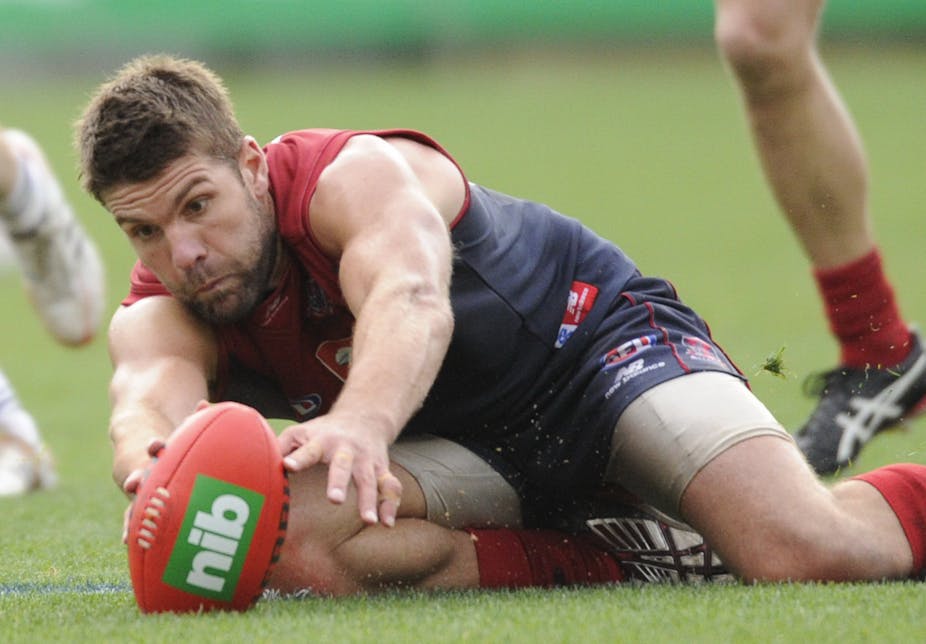Sometimes denial is understandable.
It’s no surprise that the Australian Football League maintained for so long the farcical position that “tanking’ (intentionally losing) by clubs was not a problem. It’s their standard response to any issue threatening the League.
That changed last Monday when Carlton midfielder Brock McLean suggested on TV that he left the Melbourne Demons because the club had not been entirely serious about winning games of football, with the implication it was doing so to get high draft picks.
Now faced with a public relations disaster, the League has promised severe punishment, called for people to speak out, and brazenly pronounced the issue must not be swept under the carpet. But the trouble is the AFL has built incentives to tank into the structure of their competition. And any systematic attempts to deal with the problem might do more harm than good.
For all its corporatisation Australian Rules football remains driven by the passions of fans: it depends on the dreams of barrackers, along with their absurd faith that the team they love is destined to one day win the premiership. At the centre of it all is hope – that the new players, coach or gameplan will bring the glory that has been promised. That eventual triumph is on its way.
The Australian Football League has been alive to this, borrowing "equalisation” measures from their North American counterparts, the NFL, since the 1980s. For the intended outcome of the draft and salary cap is to reinforce the belief that every team will be able to compete equally for the premiership cup.
And despite various obstacles, these equalisation strategies have been remarkably successful. Indeed, while the growth in audiences – and thus revenue – of the AFL has generally been credited to the national expansion of the League, the equalisation strategies have been a key factor. Only five different clubs won a premiership in the two decades before the AFL began to expand its competition in 1988. Since then all bar the two most recent teams have played finals, fourteen have been a game away from the grand final, and ten have won the flag.
Much of this has been due to the national draft which rewards the poorest teams by giving them the first pick of the most promising young footballers in the league. And although it takes place around two months after the season has ended, the national draft has become an increasingly vital occasion in footy’s liturgical calendar. Across the country, alone and in groups, huddled around TV’s, radios and the internet, barrackers hope for the recruitment of a saviour: for the player, or players, who will lead their club to a premiership flag.
History gives these fans due cause for optimism. Early draft picks such as Scott Pendelbury and Dale Thomas (Collingwood), Lance Franklin and Jarryd Roughead (Hawthorn), and Chris Judd (West Coast) have all played key roles in premiership victories during the last decade.
It often makes sense then, for those clubs who cannot make the finals to try and lose rather than do everything possible to win. It’s a disturbing side-effect of equalisation, and something the AFL clearly needs to counter. But how?
The AFL is currently taking the line that it can police tanking, but apart from the most extreme cases, this is unlikely to be effective. Clubs down the bottom of the ladder often send key players off for season-ending surgery when they would still be able to play at a high level if the club was still competing for that year’s premiership. How can this be policed? Is the AFL to insist that it vet every decision to operate on a player?
A more effective solution would be to modify the draft. The AFL has already made one change by lowering the value of the priority picks given to teams who perform horrendously for two years in a row. A further step would be to create a lottery for the picks as the NBA has done in the US whereby the teams who finish lowest have more chance, but no guarantee, of being awarded the first draft pick. Unfortunately the most recent NBA season showed that this could simply lead to multiple teams tanking in order to try and “win” the first pick.
Even more radical is the suggestion of moving to a two-league relegation system. This would make winning of the utmost importance for the bottom teams, and augment the race to the flag with compelling narratives of survival and despair. Nevertheless, a two-tier league would require a huge injection of funds to create the second-tier, the abandonment of the equalisation strategies – or at least the draft – and increase the need for new fans from a relatively small population.
The AFL often seems impregnable. Despite the scandals and angst it marches on. Membership figures, crowd numbers, and television audiences have all increased markedly over the past decade. A key reason for this is that even when supporters become disaffected by the game they still love their club and buy into the dreams of future glory. But these dreams of glory are fragile, and it is the AFL’s need to nurture the hopes of barrackers that explains its reluctance to move firmly against tanking.

